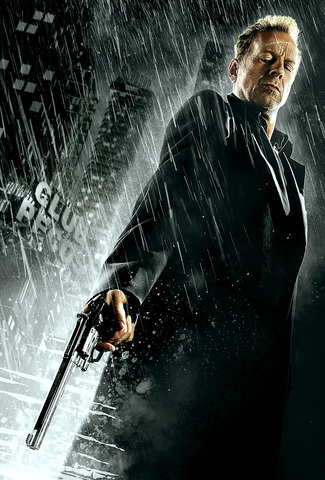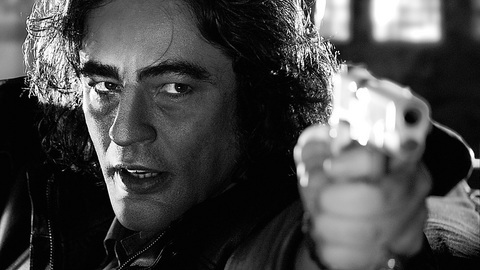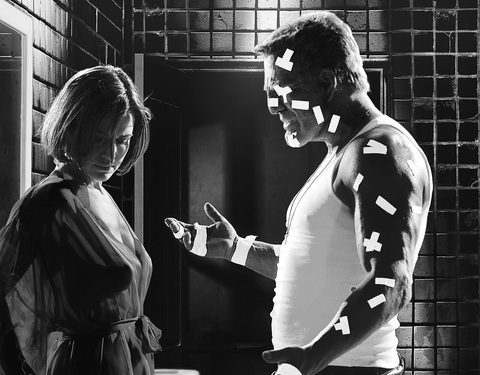There are 8 million stories in the naked city and almost as many crammed into Sin City. Based on the comic book series of the same name by Frank Miller, who directed the film with Robert Rodriguez, this slavishly faithful screen adaptation tracks the ups and downs (mostly downs) of tough guys and dolls recycled from the lower depths and bottom shelves of pulp fiction. Instead of Raymond Chandler, though, with his weary allusions to Shakespeare and Keats, these hardboiled tales owe a debt to the American primitivism of Mickey Spillane and comic book legends like William Gaines.
Set in a nowhere metropolis, the film opens with a gaspingly beautiful image of a woman staring into the night. Dressed in a shimmering gown the color of newly spilled blood, she stands with her back to the camera, oblivious. That gives us time to register that this red is the only color in a landscape exclusively painted hot white, bottomless black and silvery gray. It also gives the narrator (Josh Hartnett) time to creep up on her. Soon, the man offers the woman a cigarette and takes something far more precious from her in return. With a few short sentences and an act of violence, the filmmakers telescope the death and desire to follow, as well as the underlying brutality of their world.
Sin City unfolds in a permanent midnight with only an intermittent splash of color to brighten the dark. In this shadowland, the men wear trench coats and chips on their shoulders, while the women wear next to nothing at all. Aesthetically speaking, the filmmakers have a thing for pneumatic breasts and bondage wear, and the women in Sin City are conceived along the same fetishistic lines as many comic strip heroines. Dressed in push-up bras and even a pair of chaps, they all look as if they could be on the stroll in Pigalle, including a parole officer, who likes to ramble around in thong panties and heels. It is a vision of women so comically retro you half expect the 1950s pinup Bettie Page to swing by for some fun.

Like Pulp Fiction, which clearly influences its structure, Sin City turns on three tales lifted out of Miller's original. The first involves a detective with a bad ticker, Hartigan (Bruce Willis), who intersects with a sex fiend (Nick Stahl) and an 11-year-old (Makenzie Vega), who grows up to become an exotic dancer (Jessica Alba) with an undulating belly and a nice way with a lasso. Little girls apparently do not enjoy a whole lot of career choices in Sin City. Except for that parole officer (Carla Gugino) and a waitress (Brittany Murphy), all the other women in this burg are prostitutes, members of a snarling sisterhood bound together by greed, kink, self-interest and numerous lethal weapons. That sisterhood features most heavily in the story hooked to a psychopath named Dwight (Clive Owen). Like the rest of the film's menagerie, Dwight is a conceit rather than a character, and would barely register save for the fact that Owen is easy on the eyes, whether jumping out of a window or locking lips with his own personal demon (Rosario Dawson).
Dwight's story, a tale of jealousy and misidentification, finds him crossing paths with a thug, Jackie Boy (a barely recognizable, criminally uglified Benicio Del Toro), and not much more. Jackie Boy, whose moniker recalls that of Robert De Niro's doomed Johnny Boy in Mean Streets, has the
makings of a tragedy, but the filmmakers don't have the will. He just crashes and burns, sacrificed for the usual blood sport.

And so it goes -- pow, wham, splat. The most developed story hinges on Marv, a slab of sub-humanity played by a thoroughly unrecognizable Mickey Rourke. With a face like roadkill and a pumped up body, Marv is at once the classic cartoon underdog and a pulp superman, a lonely guy who can take vengeance on the world by blowing like Krakatoa. (Needless to say, he is also a classic identification figure for the stereotypical comic-book reader.) Like Hartigan and to an extent Dwight, Marv is also an avenger of women, a knight in shining black. Marv has a dream called Goldie (Jaime King), a stealthy enemy (Elijah Wood) and a taste for stomach-flipping violence. You may not look at your dog the same way after you watch Marv go about his gory work. The scene with Marv and what turns out to be a hungry hound could have been published in William Gaines' EC horror comics. Originally published in 1950, these comics hit a postwar America with an understandably strong appetite for horror, and are filled with Grand Guignol laughs, distressed damsels and terrors bubbling under the surface. Like many comic book artists, Miller was influenced by EC, but his voice and style are also steeped in the romantic fatalism of film noir. There is nothing urgent or remotely profound about Sin City and its pastiche of styles; here, the text is the subtext, and the horror is abstract, not rooted in the real. But Miller certainly knows how cool a guy looks, or thinks he does, walking its mean streets.
I bring up EC because Sin City has been made with such scrupulous care and obvious love for its genre influences that it's a shame the movie is kind of a bore. In recent years, Rodriguez has been a careless craftsman, but he went to great lengths to honor Miller's vision, even quitting the Directors Guild because it wouldn't allow the two men to share the directing credit. But in an effort to make a faithful adaptation, Rodriguez put his own movie sense on hold, not even bothering with a real script. He didn't just try to make his Sin City look like a graphic novel: He tried to replicate the private experience of reading one too, slowly turned page after slowly turned page. The problem is, this is his private experience, not ours.
The soporific vibe isn't helped by the fact that Sin City has the muffled, airless quality of some movies loaded with computer-generated imagery. The film feels as if it takes place under glass, which makes conceptual sense, since the characters don't bear any resemblance to actual life: They don't have hearts (or brains), so there's no reason they should have lungs or air to breathe. At the same time, Miller and Rodriguez's commitment to absolute unreality and the absence of the human factor mean it's hard to get pulled into the story on any level other than the visceral. When stuff goes blam, you jump like someone who's landed on a whoopee cushion. But then you just sit there, wrap yourself in the dark and try not to fall asleep.


One of the most important gripes that Taiwanese have about the Democratic Progressive Party (DPP) is that it has failed to deliver concretely on higher wages, housing prices and other bread-and-butter issues. The parallel complaint is that the DPP cares only about glamor issues, such as removing markers of Chinese Nationalist Party (KMT) colonialism by renaming them, or what the KMT codes as “de-Sinification.” Once again, as a critical election looms, the DPP is presenting evidence for that charge. The KMT was quick to jump on the recent proposal of the Ministry of the Interior (MOI) to rename roads that symbolize

On the evening of June 1, Control Yuan Secretary-General Lee Chun-yi (李俊俋) apologized and resigned in disgrace. His crime was instructing his driver to use a Control Yuan vehicle to transport his dog to a pet grooming salon. The Control Yuan is the government branch that investigates, audits and impeaches government officials for, among other things, misuse of government funds, so his misuse of a government vehicle was highly inappropriate. If this story were told to anyone living in the golden era of swaggering gangsters, flashy nouveau riche businessmen, and corrupt “black gold” politics of the 1980s and 1990s, they would have laughed.

It was just before 6am on a sunny November morning and I could hardly contain my excitement as I arrived at the wharf where I would catch the boat to one of Penghu’s most difficult-to-access islands, a trip that had been on my list for nearly a decade. Little did I know, my dream would soon be crushed. Unsure about which boat was heading to Huayu (花嶼), I found someone who appeared to be a local and asked if this was the right place to wait. “Oh, the boat to Huayu’s been canceled today,” she told me. I couldn’t believe my ears. Surely,

When Lisa, 20, laces into her ultra-high heels for her shift at a strip club in Ukraine’s Kharkiv, she knows that aside from dancing, she will have to comfort traumatized soldiers. Since Russia’s 2022 invasion, exhausted troops are the main clientele of the Flash Dancers club in the center of the northeastern city, just 20 kilometers from Russian forces. For some customers, it provides an “escape” from the war, said Valerya Zavatska — a 25-year-old law graduate who runs the club with her mother, an ex-dancer. But many are not there just for the show. They “want to talk about what hurts,” she